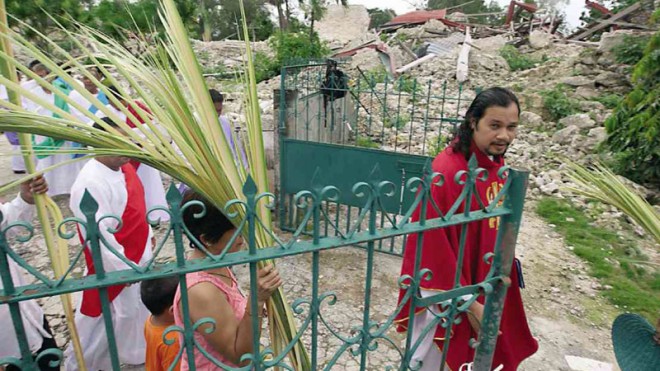
AMONG RUINS IN BOHOL Fr. Warren Abarquez leads devotees past the ruins of an old church in Maribojoc town during Palm Sunday rites. TONEE DESPOJO/CEBU DAILY NEWS
MARIBOJOC, Bohol—Emilia Cuering, 61, woke up early on Sunday morning to gather six long palm fronds from the palm tree near her house in Barangay (village) Bayacaba.
Cuering brought the fronds to Barangay Poblacion where she heard the 7:30 a.m. Palm Sunday Mass held in a makeshift structure beside the rubble where the old church used to stand.
She brought her 4-year-old granddaughter, Jona Mae Alimana who, until now, had not been sleeping well since the Oct. 15 earthquake last year that brought this island-province to its knees.
After the Mass, she was among the more than 200 parishioners who lined up to have their palm fronds blessed in keeping with the Catholic tradition.
Cuering told the Inquirer that she planned to form her palm fronds into crosses and place these on the door of her house and on the altar.
She said she learned how to make “palaspas (palm fronds used during Palm Sunday)” when she was 6 years old.
This Holy Week, she said she wanted to thank the Lord for sparing her family during the devastating earthquake, but at the same time, pray that her granddaughter would recover from her trauma following the tragedy.
“I pray that we will be given good health and be protected from calamities that may happen,”she added.
Fr. Warren Abarquez, Maribojoc parish priest, said the Palm Sunday Mass on the open grounds beside the rubble of what used to be the Holy Cross Parish Church, also known as the San Vicente Ferrer Parish Shrine.
The church was among the six churches destroyed during the earthquake. The five others were in the towns of Loboc, Clarin, Inabanga, Loon and Tubigon.
At least 17 churches were also damaged in the quake. These are in Antequera, Baclayon, Bilar, Calape, Carmen, Corellas, Cortes, Danao, Dauis, Dimiao, Lila, Loay, Panglao, Sikatuna, Tagbilaran, Talibon and Trinidad.
The National Museum and the National Historical Commission of the Philippines declared the church in Maribojoc a national cultural treasure in 2010 and a national historical landmark in 2009.
After the quake, parishioners were able to raise P500,000 that was used to construct a temporary church.
The structure doesn’t have walls except at the altar. The roof, made of GI sheets, is held by four steel bars.
The photo of the old altar was printed on a tarpaulin and was displayed on the temporary church to remind the parishioners of how their old church looked like, Abarquez said.
Restoration of the old church may take time as the funding would still come from the national government, he said.